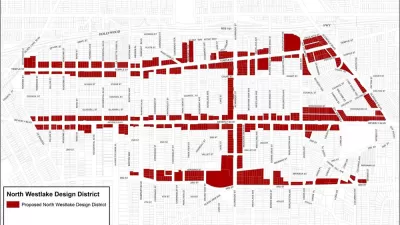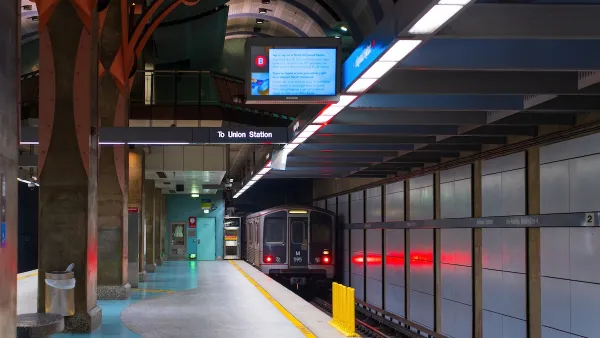In 2006, the Los Angeles Planning Dept. launched an urban design studio to turn Los Angeles into a more pedestrian-friendly city. The studio has gone on to create a set of walkability guidelines, and has more ambitious goals ahead.
Tibby Rothman of The Architect's Newspaper sat down with planners Emily Gabel-Luddy, and Simon Pastucha from the Urban Design Studio. They talked about the Studio's 11 Urban Design Principles, which are a set of values to which developers would be required to subscribe when seeking entitlements.
"AN: The truth underlying the Urban Design Principles is that all the great cities of the world came into being based on the human scale and prior to the advent of automobiles, and it's the design studio's intent to focus back to the human scale. Give me a practical example of what sort of implementation that might entail.
Emily Gabel-Luddy: Let me go to the Street Standards in Downtown Los Angeles. It was our goal that the city move away from an auto-centric proposition to one that emphasizes the pedestrian and mass transit. And so we spearheaded the idea of 15-foot-minimum-wide sidewalks in the dense urban core of our city. The reason this is so significant is because it lets all the developers and property owners have so much more room to put their outdoor café accessories-their tables and chairs-which in turn begins to cultivate the kind of social commerce among neighborhoods, residents, and office workers that was really part of cities prior to the automobile playing such an overriding part in how the public realm is defined and utilized.
AN: How will the Urban Design Principles dovetail into existing neighborhood plans? Don't architects have enough regulations on their plate already?
Simon Pastucha: Both the Urban Design Principles and the Downtown Design Standards are set up as a set of ideas to incorporate into your design. They're not a set of standard requirements saying that you have to have ‘this' at a certain point or a certain place. They just say: How do you meet the intent of these?
EGL: It's not a design review, it's not an ordinance. It says: Here's the value, now tell us how your project has achieved that value. I don't think true design comes from telling architects how to design their buildings. True design comes from having the architect reflect on how that building achieves value that is expressed in a way that is appropriate to a local community."
FULL STORY: Q&A: LA Urban Design Studio

Planetizen Federal Action Tracker
A weekly monitor of how Trump’s orders and actions are impacting planners and planning in America.

Maui's Vacation Rental Debate Turns Ugly
Verbal attacks, misinformation campaigns and fistfights plague a high-stakes debate to convert thousands of vacation rentals into long-term housing.

San Francisco Suspends Traffic Calming Amidst Record Deaths
Citing “a challenging fiscal landscape,” the city will cease the program on the heels of 42 traffic deaths, including 24 pedestrians.

Amtrak Rolls Out New Orleans to Alabama “Mardi Gras” Train
The new service will operate morning and evening departures between Mobile and New Orleans.

The Subversive Car-Free Guide to Trump's Great American Road Trip
Car-free ways to access Chicagoland’s best tourist attractions.

San Antonio and Austin are Fusing Into one Massive Megaregion
The region spanning the two central Texas cities is growing fast, posing challenges for local infrastructure and water supplies.
Urban Design for Planners 1: Software Tools
This six-course series explores essential urban design concepts using open source software and equips planners with the tools they need to participate fully in the urban design process.
Planning for Universal Design
Learn the tools for implementing Universal Design in planning regulations.
Heyer Gruel & Associates PA
JM Goldson LLC
Custer County Colorado
City of Camden Redevelopment Agency
City of Astoria
Transportation Research & Education Center (TREC) at Portland State University
Jefferson Parish Government
Camden Redevelopment Agency
City of Claremont





























